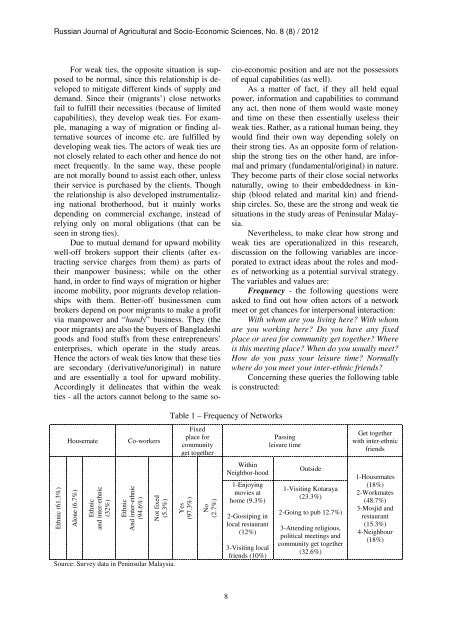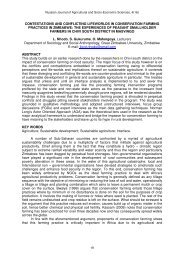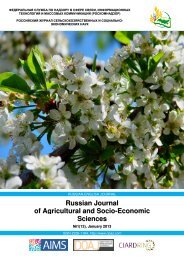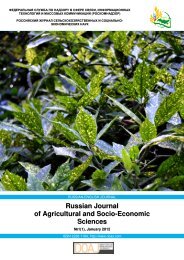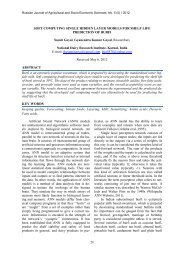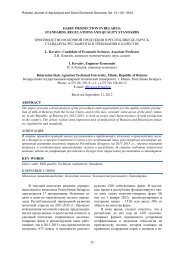<strong>Russian</strong> <strong>Journal</strong> <strong>of</strong> <strong>Agricultural</strong> <strong>and</strong> <strong>Socio</strong>-<strong>Economic</strong> <strong>Sciences</strong>, No. 8 (8) / 2012For weak ties, the opposite situation is supposedto be normal, since this relationship is developedto mitigate different kinds <strong>of</strong> supply <strong>and</strong>dem<strong>and</strong>. Since their (migrants’) close networksfail to fulfill their necessities (because <strong>of</strong> limitedcapabilities), they develop weak ties. For example,managing a way <strong>of</strong> migration or finding alternativesources <strong>of</strong> income etc. are fulfilled bydeveloping weak ties. The actors <strong>of</strong> weak ties arenot closely related to each other <strong>and</strong> hence do notmeet frequently. In the same way, these peopleare not morally bound to assist each other, unlesstheir service is purchased by the clients. Thoughthe relationship is also developed instrumentalizingnational brotherhood, but it mainly worksdepending on commercial exchange, instead <strong>of</strong>relying only on moral obligations (that can beseen in strong ties).Due to mutual dem<strong>and</strong> for upward mobilitywell-<strong>of</strong>f brokers support their clients (after extractingservice charges from them) as parts <strong>of</strong>their manpower business; while on the otherh<strong>and</strong>, in order to find ways <strong>of</strong> migration or higherincome mobility, poor migrants develop relationshipswith them. Better-<strong>of</strong>f businessmen cumbrokers depend on poor migrants to make a pr<strong>of</strong>itvia manpower <strong>and</strong> “hundy” business. They (thepoor migrants) are also the buyers <strong>of</strong> Bangladeshigoods <strong>and</strong> food stuffs from these entrepreneurs’enterprises, which operate in the study areas.Hence the actors <strong>of</strong> weak ties know that these tiesare secondary (derivative/unoriginal) in nature<strong>and</strong> are essentially a tool for upward mobility.Accordingly it delineates that within the weakties - all the actors cannot belong to the same socio-economicposition <strong>and</strong> are not the possessors<strong>of</strong> equal capabilities (as well).As a matter <strong>of</strong> fact, if they all held equalpower, information <strong>and</strong> capabilities to comm<strong>and</strong>any act, then none <strong>of</strong> them would waste money<strong>and</strong> time on these then essentially useless theirweak ties. Rather, as a rational human being, theywould find their own way depending solely ontheir strong ties. As an opposite form <strong>of</strong> relationshipthe strong ties on the other h<strong>and</strong>, are informal<strong>and</strong> primary (fundamental/original) in nature.They become parts <strong>of</strong> their close social networksnaturally, owing to their embeddedness in kinship(blood related <strong>and</strong> marital kin) <strong>and</strong> friendshipcircles. So, these are the strong <strong>and</strong> weak tiesituations in the study areas <strong>of</strong> Peninsular Malaysia.Nevertheless, to make clear how strong <strong>and</strong>weak ties are operationalized in this research,discussion on the following variables are incorporatedto extract ideas about the roles <strong>and</strong> modes<strong>of</strong> networking as a potential survival strategy.The variables <strong>and</strong> values are:Frequency - the following questions wereasked to find out how <strong>of</strong>ten actors <strong>of</strong> a networkmeet or get chances for interpersonal interaction:With whom are you living here? With whomare you working here? Do you have any fixedplace or area for community get together? Whereis this meeting place? When do you usually meet?How do you pass your leisure time? Normallywhere do you meet your inter-ethnic friends?Concerning these queries the following tableis constructed:Ethnic (61.3%)HousemateAlone (6.7%)Ethnic<strong>and</strong> inter-ethnic(32%)Co-workersEthnicAnd inter-ethnic(94.6%)Not fixed(5.3%)Source: Survey data in Peninsular Malaysia.Table 1 – Frequency <strong>of</strong> NetworksFixedplace forcommunityget togetherYes(97.3%)No(2.7%)WithinNeighbor-hood1-Enjoyingmovies athome (9.3%)2-Gossiping inlocal restaurant(12%)3-Visiting localfriends (10%)Passingleisure timeOutside1-Visiting Kotaraya(23.3%)2-Going to pub 12.7%)3-Attending religious,political meetings <strong>and</strong>community get together(32.6%)Get togetherwith inter-ethnicfriends1-Housemates(18%)2-Workmates(48.7%)3-Mosjid <strong>and</strong>restaurant(15.3%)4-Neighbour(18%)8
SULTANA NAYEEM, University <strong>of</strong> DhakaTable 1 denotes that apart from maintainingnetworks with their housemates, workmates <strong>and</strong>neighbors, Bangladeshis also attend different political<strong>and</strong> religious meetings <strong>and</strong> cultural celebrations.There are certain places for this kind <strong>of</strong>celebration which the migrants (both poor <strong>and</strong>better-<strong>of</strong>f) try to visit. It is found that the better<strong>of</strong>fmigrants become the conveners <strong>of</strong> these cultural<strong>and</strong> politico-religious programs, where poormigrants participate in their free times. They visitKotaraya (‘Bangla Bazaar’) to buy Bangladeshigoods from ethnic enterprises as well as to meetpowerful labor brokers.The data also indicates that the migrants’common living <strong>and</strong> working environment providesthem the opportunity for regular contactwith their ethnic <strong>and</strong> inter-ethnic friends. Thecommon living <strong>and</strong> working niche as well as everydayinteractions enable them to develop friendshipswith each other. In fact, along with thecommon experiences <strong>of</strong> immigration <strong>and</strong> everydaycontacts, they (the Bangladeshis) face moreor less the same realities as neighbors <strong>and</strong> workmates.Besides, they are found to spend their leisurehours together in their common surroundings(apart from visiting distant places <strong>and</strong> weaktie based networks). However, while the locals donot need to face an alien way <strong>of</strong> life (since theyare all insiders there), owing to regular correspondenceeither in local restaurants or at theirhome <strong>and</strong> work places both <strong>of</strong> these groups stillget the chance to construct networks. Bangladeshismeet the locals <strong>of</strong> Muslim belief in localmosque <strong>and</strong> “suraus”. Because <strong>of</strong> the same religiousbackground (Islam) most <strong>of</strong> the Bangladeshimigrants <strong>and</strong> their (Malay, Indian Muslim <strong>and</strong>Indonesians etc.) friends enjoy <strong>and</strong> practice moreor less similar religious festivals <strong>and</strong> rituals.Strength <strong>and</strong> Intensity - To pull out informationon the emotional intensity, reciprocal exchange<strong>and</strong> respective obligations to each othersin the network some questions were asked, suchas:Whom do you consider your friend? How doyou define your friend? Why do you maintainnetworks? How do you manage jobs <strong>and</strong> workpermits? How did you get your dwelling place?Who introduced you to your employer? Where doyou go to acquire a better job <strong>and</strong> other facilities?Do you pay them? Why do you assistpoor/undocumented workers? How did you migrate?How do you send remittance to homecountry? How did you learn Bahasa? How doyou manage to cope here? Why are you livingtogether with others? How did/will you manageto stay longer? Why do you maintain homel<strong>and</strong>contacts? Why did you prefer inter-ethnic marriage?How did you meet your inter-ethnicspouse? How did you manage your business visa?How did you get this property? How did youmanage risks?As a matter <strong>of</strong> fact, friendship ties werefound primarily within people <strong>of</strong> the same socioeconomicbackground. For example, un-skilled<strong>and</strong> semi-skilled workers identified other workersas their friends who <strong>of</strong>ten also were their housemates,neighbors <strong>and</strong> workmates. In the sameway, no pr<strong>of</strong>essional <strong>and</strong> businessman was foundwho considered a semi-skilled <strong>and</strong> un-skilledworker as his or her friend. It is not likely that all<strong>of</strong> the neighbors or co-workers converted eachother’s friend. Nor was national brotherhood consideredas the only factor for friendship. Rather,migrants emphasized those as their friends whomthey could trust in need. According to RanjanMallik (he used to work in a furniture factory <strong>of</strong>Kajang),“My co-workers, likewise Bangladeshiworkers in Kajangjaya, are my friends. We arenot so well-<strong>of</strong>f. We have to send money to ourfamilies. I also have some friends in my hometown. They take care <strong>of</strong> my family. Sometimes Isend gifts for them or try to make phone calls.But I don’t have any girlfriend. I also don’t likethe rich <strong>and</strong> educated Bangladeshis. They behavelike we are not their countrymen. I know theywould not assist me in danger. I don’t know anyfemale workers. It is better to avoid them, becausethey might create extra burdens <strong>and</strong> ourfamilies would not be happy about that.”It can be ascertained (from the above comment)that pr<strong>of</strong>essionals <strong>and</strong> businessmen generallyare not friends with poor income groups. Atthe same time, it also assists us to know whatthey (the poor migrants) expect from theirfriends. Provision <strong>of</strong> trust, certainty, regular correspondence<strong>and</strong> assistance are the qualitiesamong others through which their friendship isdefined. On the basis <strong>of</strong> these moral <strong>and</strong> reciprocalobligations (for each other) they maintainfriendship even with their home-based residues.Transnational networking helps them by allowingthem to maintain contact with their home basedfriends. They (the migrants) are also assured thattheir friends reciprocate their obligations to themigrants by taking care <strong>of</strong> their families. These9


